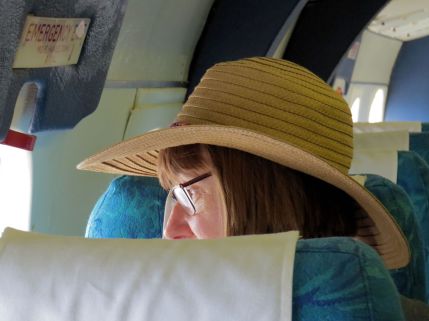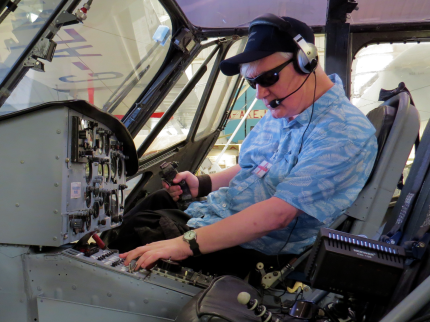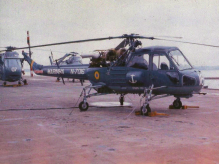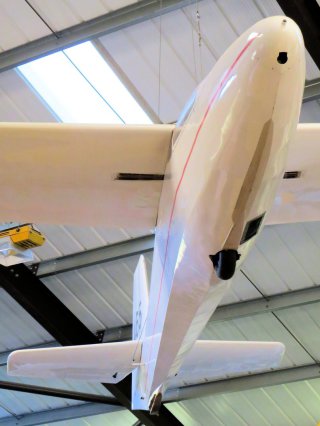
Major exhibits
Miles Magister
Miles Magister L6906
The Magister two-seat training aircraft was built at Woodley Airfield as construction number 2078 and registered T9841. Later it took the civil registration G-AKKY. Much of the fuselage had to be rebuilt following the methods of its original construction.
Impression of Magister L6906
Handley Page Herald
Miles aircraft went out of business in 1946 and within two years Handley Page bought the factory and began its expansion to build their own aircraft. By the late 1950s they introduced the Herald short-haul airliner.
Handley Page Herald G-APWA
Built at Woodley, G-APWA was the third Herald built and was the first production model. It first flew in October 1959 and was loaned along with another Herald to Prince Philip for his 1962 tour of South America. The Prince logged nearly 100 flying hours as pilot for the trip.
Lavinia, possibly lost in wishful thoughts of warmer climes?
The purpose of the loan was to try to boost sales of the aircraft in South America which was seen as a key market for the Herald. Sadly it made little difference as its main competitors, the Fokker F27 and the Avro 748, were already well established. Only 49 Heralds were built including prototypes. A 50th airframe (c/n 193) was built but only used for water tank pressure testing. The last operational Herald was retired in 1999.
Impression of Herald G-APWA
G-APWA was rescued from Southend Airport in 1993 and 14,000 man hours were spent by the museums’ volunteers in its restoration. Another way to express that is to imagine one man working eight hours each day, with weekends off, bank holidays off and four weeks holiday per year. It would take that one man about seven and a half years to complete. The aircraft is open to visitors for embarkation and often there is a volunteer at hand to assist with any questions.
Fairey Gannet T.5
The Fairey Gannet was primarily designed as an Anti-Submarine Warfare aircraft (ASW). Gannets were constructed by Fairey Aviation at Hayes then shipped to their facility at White Waltham for final assembly and fitting out.
Fairey Gannet XG833
The Gannet at the museum is a T.5 Training version. It has dual controls and the instructor in the second cockpit, has a basic mirror periscope to allow him to see forward.
Impression of Fairey Gannet T5 XG833
Gannet XG833 first flew in May 1957. It spent much of its life in storage but did serve with 849 NAS at RNAS Culdrose and later with the same unit at RNAS Brawdy. Owned by the Fleet Air Arm Museum at Yeovilton it has been on loan to the Museum of Berkshire Aviation since March 1996.
Fairey Gannet T5 XG833
Westland Scout
Westland Scout XP849
Westland Scouts were built by Fairey Aviation at Hayes and shipped to White Waltham for final assembly and fitting out. A similar arrangement applied to the Scout naval sister, the Westland Wasp. The most obvious difference between the two was that the Scout had skids whilst the Wasp had a four-wheel undercarriage for ease of movement on ship flight decks.
Impression of Westland Scout XP849.
It is actually wearing a bogus registration (see lower down)
The Westland Scout was a light utility helicopter serving with the British Army and a number of foreign armies. Often used on the battlefield in reconnaissance, casualty evacuation (CASEVAC) and light attack roles, it could also carry 3 or 4 troops depending on the type of rear doors fitted.
Gary ‘operating’ the radio of the Scout
Westland Scout XP849
Scout XP849 has been on long term loan from a private individual since October 2010. It is presented in the colours and markings of the Empire Test Pilots School.
An impression of the museum’s Westland Scout in what may have been its original camoulflage and registration
Scout XP849 is wearing a false registration. The real XP849 is another Scout which is based in New Zealand and is in flying condition. The correct registration of the museum’s aircraft is XP895 and the illustration above is an impression of how it may have looked in British Army service.
Dave reading an extraordinarily interesting book
EoN Olympia 465
The EoN Olympia 465 glider was designed and built for the World Glider Championships at South Cerney in 1965. Only two 465s were built. The other 465 was destroyed in an accident in South Africa in 2001. None of the 460 series were particularly successful in competitions. Their wooden construction was already becoming obsolete with the introduction of composite materials. Some are still flying however.
EoN Olympia 465
Other major exhibits at the museum
Click on an image to view an enlarged illustration then click on the cross in the lower left corner to minimise it.
Anomalies in registrations of exhibits
Martinet Icelandic registration TF-SHC; RAF registration MS902; Master wings registration DK964
Magister RAF registration on display L6906; alternative RAF registration T9841; civil registration G-AKKY
Scout Empire Test Pilot School registration XP849; British Army registration XP895; real XP849 based in New Zealand
Student: Museum display G-MIOO; civil registration G-APLK; military registration XS941
This exhibit is tail from Miles Gemini G-AKEJ cn 6482. I used this photo along with images from the Internet to construct the image below.
Acknowledgements
Many thanks for the help, support and guidance on this and other articles within this website to the Museum of Berkshire Aviation. For the latest information, opening days, times and the location of the museum, visit the homepage of their website by clicking on the button below:
Information contained in these pages is correct as of 2018
My name is Gary Flint. I'm author, photographer & illustrator for Postcards from Slough. If you wish to make any comments on the contents of the website please click on the ladybird below:
Gary Flint
08/03/1961 - 09/04/2019
Postcards from Slough is an independently funded website. We are open to offers of sponsorship from companies that have any connections to the town. To contact us please click on the ladybird below:
Chalvey Community Forum
Postcards from Slough is linked with a local action group the Chalvey Community Forum. The group liaises with various local organisations in order to improve the quality of life for residents in the ward of Chalvey and Salt Hill. To learn more please click on the maidenhair leaf below:
Museum of Berkshire Aviation
I volunteer as a guide at the Museum of Berkshire Aviation. It is a special museum and if you would like to know more about the museum then please click on the motif below:
To learn more about the museums activities while staying within this website click on the tab at the top of the page or on the motif below:
Graces Guide
Postcards from Slough uses some images from Grace's Guide. Click on the button below:
British Listed Buildings
Postcards from Slough contributes material to British Listed Buildings and uses the site for cross referencing purposes. Click on the button below:









